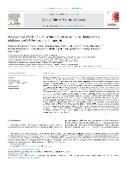Pro-cognitive effects of dual tacrine derivatives acting as cholinesterase inhibitors and NMDA receptor antagonists

Autor
Chvojková, Markéta
Kolář, David
Kováčová, Katarína
Čejková, Lada
Horák, Martin
Datum vydání
2024Publikováno v
Biomedicine & PharmacotherapyRočník / Číslo vydání
176 (July)ISBN / ISSN
ISSN: 0753-3322ISBN / ISSN
eISSN: 1950-6007Informace o financování
MSM//LX22NPO5107
//SVV260533
UK/COOP/COOP
FN/I-FN/I-FNHK-RVO
MZ0/NU/NU20-08-00296
Metadata
Zobrazit celý záznamTato publikace má vydavatelskou verzi s DOI 10.1016/j.biopha.2024.116821
Abstrakt
Therapeutic options for Alzheimer's disease are limited. Dual compounds targeting two pathways concurrently may enable enhanced effect. The study focuses on tacrine derivatives inhibiting acetylcholinesterase (AChE) and simultaneously N-methyl-D-aspartate (NMDA) receptors. Compounds with balanced inhibitory potencies for the target proteins (K1578 and K1599) or increased potency for AChE (K1592 and K1594) were studied to identify the most promising pro-cognitive compound. Their effects were studied in cholinergic (scopolamine-induced) and glutamatergic (MK-801-induced) rat models of cognitive deficits in the Morris water maze. Moreover, the impacts on locomotion in the open field and AChE activity in relevant brain structures were investigated. The effect of the most promising compound on NMDA receptors was explored by in vitro electrophysiology. The cholinergic antagonist scopolamine induced a deficit in memory acquisition, however, it was unaffected by the compounds, and a deficit in reversal learning that was alleviated by K1578 and K1599. K1578 and K1599 significantly inhibited AChE in the striatum, potentially explaining the behavioral observations. The glutamatergic antagonist dizocilpine (MK-801) induced a deficit in memory acquisition, which was alleviated by K1599. K1599 also mitigated the MK-801-induced hyperlocomotion in the open field. In vitro patch-clamp corroborated the K1599-associated NMDA receptor inhibitory effect. K1599 emerged as the most promising compound, demonstrating pro-cognitive efficacy in both models, consistent with intended dual effect. We conclude that tacrine has the potential for development of derivatives with dual in vivo effects. Our findings contributed to the elucidation of the structural and functional properties of tacrine derivatives associated with optimal in vivo pro-cognitive efficacy.
Klíčová slova
Alzheimer disease, Receptors, N-Methyl-D-Aspartate, acetylcholinesterase, cognition, polypharmacology, tacrine
Trvalý odkaz
https://hdl.handle.net/20.500.14178/2545Licence
Licence pro užití plného textu výsledku: Creative Commons Uveďte původ 4.0 International







